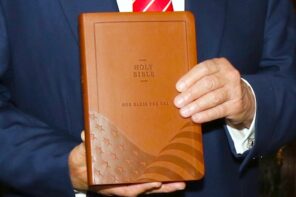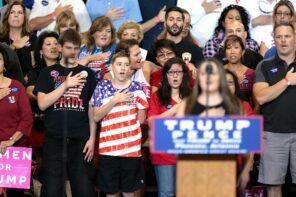During the Republican primary, Donald Trump was criticized for failing to challenge a supporter who stood up and declared,* “We have a problem in this country—it’s called Muslims. We know our current president is one.” Later, after the shooting in San Bernardino, California, Trump called for the banning of all immigration of Muslims until “we know what the hell is going on.” His rise to being the presumed nominee, and his considerable inroads into grassroots evangelical votes, accompanied (and no doubt benefited from) such messages.
Around the same time late last year, the Wheaton College political science professor Larycia Hawkins was put on “leave” following her donning of a hijab and proclamation that Muslims and Christians worship the same God. Later, Hawkins and the school came to a mutual parting of the ways, and Hawkins has since taken a new post at the University of Virginia. Still, the episode led some to wonder whether there was to be a repeat of earlier works about the scandal of the evangelical mind, and a possible brain drain from campuses such as Wheaton.
The contemporary Muslim-American experience of freedom, surveillance, and suspicion reflects much of the long history of race, religion, and “difference” in American history. The fears harken back to nativist movements familiar in American history, most especially to the Know-Nothing Party of the 1850s, which tried to ban Catholic immigration and perceived Catholics as a dire threat to the American Republic, just as some Americans perceive Muslims in the 2016 electoral cycle. Perhaps most importantly, it suggests the ways in which, for some Americans, “Muslim” elides categories of both race and religion, and stirs up deep-rooted American tropes of the bounds of racial and religious habitation.
The passing of Muhammad Ali calls to mind a period both of that surveillance and suspicion, but also a different era between Muslim-Americans and the evangelical establishment that seems to be waning. In 1979, Ali visited Billy Graham in Montreat, North Carolina, after which Graham declared that “Ali’s primary beliefs are something we could all believe.”
Graham perceived Ali as a “healer” (painfully ironic now, as this was just about the time that Ali’s Parkinson’s disease was becoming evident), and the two shared things they had in common, including “love and belief in mankind.”
Ali came away from the meeting impressed with Graham: “I always said if I was a Christian, I would want to be a Christian like him.” Graham later wrote to Rabbi Marc Tannenbaum, Director of Interreligious Affairs of the American Jewish Committee, and suggested that he meet with Muhammad Ali, as Graham thought him to be warm to the state of Israel and supportive of Jews generally.
That was then, but this is now; that was Billy Graham’s evangelical vision, while his son, Franklin, has taken a stand with Trump on banning Muslims. And Trump’s endorsement by Paul Ryan this week indicates that, all in all, he and the House Republicans will be just another brick in Trump’s wall. Ryan’s resurrection of compassionate conservatism and the elder Graham’s more capacious visions for evangelical embrace of others have fallen, like George Foreman in 1974, to a rope-a-dope strategy.
*Note: a special thanks to John Schmalzbauer for the newspaper references to the Ali-Graham meeting in 1979 linked above
**Correction: an earlier version incorrectly attributed this statement to Trump himself. In fact, it was a supporter. RD regrets the error.





